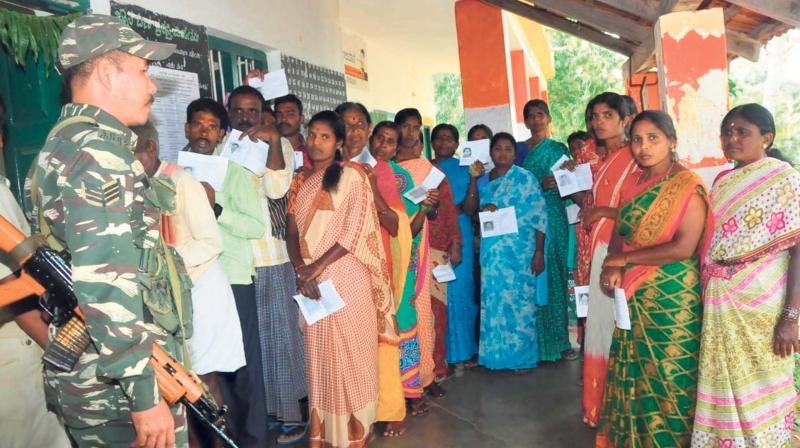Will anti-BJP alliance pass bypoll test?
As the BJP prepares its game-plan to retain power at the national level, every passing day appears to bring new challenges.

With the general elections six months away (unless the Lok Sabha is dissolved earlier), political parties seem to be firming up their strategies for this crucial vote of public confidence. The five state elections that are scheduled in the next few weeks are verily like a semi-final, which will be indicative of the public mood, though of course, in a limited set of contests. Sports enthusiasts will be quick to assert that no semi-final can ever accurately predict the results of a final though it could help in strategizing and assessing the relative strengths and weaknesses of the different contestants.
As the BJP prepares its game-plan to retain power at the national level, every passing day appears to bring new challenges. As the ruling party, it needs to stave off anti-incumbency and hope to expand its all-India presence. In 2014, it had a high strike rate in many states of North, West and Central India. Repeating the same impressive performance in these regions does not appear an easy task. The party has to defend its record in governance both at the national level and in many of those states where is it is power. Defecting attention away from the ‘unfulfilled’ promises of 2014 has led to coining of new slogans (our intentions are pure) and a possible focus away from governance and development (Ram Temple and Sabarimala). For quite some time now the party has sought to expand to new territories in the East (with some success) and in the South (with limited success). The party fervently hopes that the Prime Minister and his campaign can still save the day for the party and its organizational strength can
work to its advantage. Rajasthan and Madhya Pradesh would be a critical test of the same. The two state governments and their leadership seem to face severe challenges. Can the Prime Minister’s campaign rescue the party and of course can the divisions in the ranks of the main opposition lead to a self goal? Chattisgarh is being focused on separately as the emergence of a third force ( Ajit Jogi and the BSP alliance) has the potential of dividing the anti-BJP vote.
How is the Congress positioning itself in this electoral contest? Since its defeat in 2014, it does not seem to have truly recovered. In State Assembly polls, there is not a single state it has been able to retain its hold over and save Punjab, it has not been able to wrest power from the NDA. The November-December round of state assembly polls thus becomes critical. Can they at least retain Mizoram and/or hope to wrest any of the three states that the BJP is today in power? The electoral contest seems extremely close and could well go down to the wire.
Two issues assume relevance in this context. First, the acceptability of the Congress leadership in the emerging alliance of parties opposed to the BJP. There are enough indications from the leaders of state-based parties, that the question of leadership would be linked to the relative strength of the different parties in the new Lok Sabha. Clearly and for obvious reasons, the Congress President does not emerge as a natural choice. Having been unable to win any state for the party in the last four years (save Punjab) the Congress has been in some ways reduced to ‘one among the many players’ in the Opposition camp.
Secondly, the bane of the Congress is the factionalism within the party and the infighting among its state level leaders. If they are unable to make a dent in Madhya Pradesh and/or Rajasthan this would be a crucial factor.
The strategy of parties opposed to the BJP who are hoping for any workable alliance would need to develop an electoral plan that varies from state to state. While a national level alliance may be necessary, a specific state based approach and outline of electoral tactics would be critical. This would have to be based on an assessment of the relative strength of different players and a skillful negotiation among the key stakeholders. If Madhya Pradesh. Rajasthan and Chattisgarh are any indication, it seems more a policy of ‘United we Fall, Divided We Stand’. Yet will the ‘compulsions of political survival’ force them to come together and work with unity would be a key test.
In this context, developments in Karnataka assume significance. On Saturday, the voters in three Lok Sabha and 2 Assembly constituencies in the state cast their votes in the by-elections. The ruling alliance managed to come to an understanding on seat sharing. The results will be an indicator of whether the alliance has really worked on the ground.
The BJP received a huge setback when its Ramanagara candidate withdrew from the race and made a ‘U’ turn back to his original party. This has not just left the BJP ‘red-faced’ it has also brought to the fore the internal contradictions in the state unit of the party. Karnataka will be a test of whether ‘electoral mathematics’ alone is important or ‘political chemistry’ is equally critical.
Many felt that the coming together of the Congress and the JD(S) may create an opportunity for the BJP to ‘expand its political presence’. The Ramanagara fiasco indicates that the situation is much more complex. The bypoll results in Karnataka would be a test of whether an anti-BJP alliance can actually arrest the party’s progress and for this reason, it is being keenly watched.

